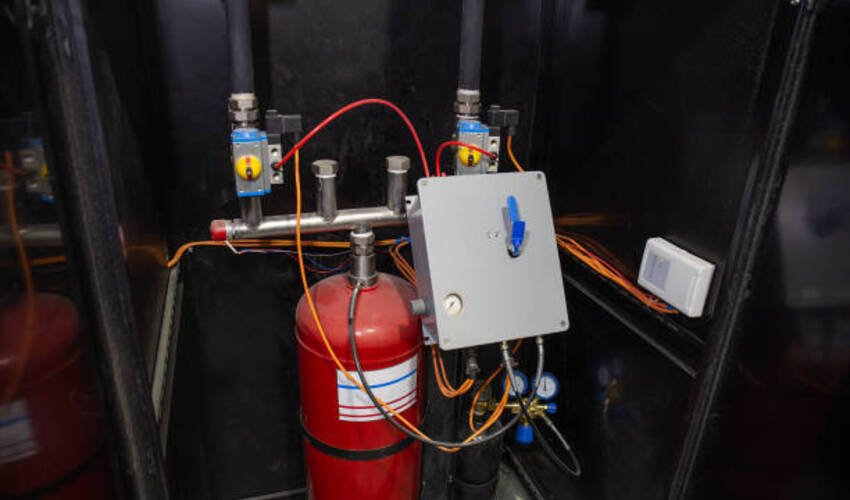Fire safety is important in every workplace and home. Fires can spread quickly and cause serious damage. Traditional fire extinguishers work, but they require human effort. A modern solution is the Aerosol Fire Suppression System. It reacts instantly and controls fire automatically. This article explains how this system works and why it improves safety.
What Is an Aerosol Fire Suppression System?
An Aerosol Fire Suppression System is a modern fire protection method. It releases fine aerosol particles into the air. These particles stop fire from spreading by cooling and blocking chemical reactions. The system does not use water or gas. Instead, it uses solid compounds that turn into aerosols when triggered. This makes it highly effective in many environments.
How Does the System Work?
When a fire starts, the system detects smoke or heat. The detection sensors send signals to the suppression unit. Instantly, the unit releases aerosol into the area. The aerosol spreads quickly and surrounds the flames. It interrupts the fire’s chain reaction. Without fuel or oxygen, the fire dies within seconds. This process is automatic. People do not need to use a fire extinguisher manually. The system controls fire even when the area is empty.
Key Benefits of Using an Aerosol Fire Suppression System
1. Quick Fire Control
The system acts within seconds. Rapid action reduces damage and increases safety.
2. No Water Damage
Unlike sprinklers, it does not use water. Sensitive equipment remains safe from water damage.
3. Safe for Equipment
The aerosol does not harm electronics. This makes it perfect for server rooms and data centers.
4. Compact Design
The system is small and easy to install. It does not require heavy tanks or pipelines.
5. Cost-Effective
Installation and maintenance costs are lower than many gas-based systems.
6. Eco-Friendly
The aerosol agents are safe for the environment. They do not harm the ozone layer.
Common Places Where It Is Used
- Data Centers – Protects servers and prevents downtime.
- Vehicles – Used in buses, trucks, and mining equipment.
- Marine Vessels – Safeguard engine rooms and cabins.
- Factories – Protects machines and production areas.
- Offices – Provides safety without damaging electronics.
- Homes – Offers extra protection for kitchens and storage areas.
Why It Improves Safety
Automatic Activation
Fires often start when no one is around. Automatic suppression reduces risk without human involvement.
Better Coverage
The aerosol spreads widely and evenly. Even hidden fire spots are reached.
Reduced Health Risks
The aerosol is safe for humans in normal concentrations. People can escape safely during activation.
Reliable Operation
The system does not need complex piping. Fewer parts mean fewer failures.
Steps for Installing the System
Step 1: Assess the Area
Identify areas that need fire protection. Look at equipment, furniture, and possible fire sources.
Step 2: Choose the Right Units
Select aerosol generators suitable for the room size. Larger rooms may need multiple units.
Step 3: Install Detection Sensors
Place heat or smoke detectors in key spots. These sensors trigger the system.
Step 4: Mount the Generators
Install aerosol generators on walls or ceilings. Ensure proper spacing for full coverage.
Step 5: Connect to Power or Battery
Most systems use electricity. Some include battery backups for emergencies.
Step 6: Test the System
Run a test after installation. Ensure that sensors and generators work correctly.
Maintenance Tips
- Regular Inspections – Check sensors and units every few months.
- Battery Checks – Ensure backup batteries work.
- Dust Cleaning – Keep units free from dust.
- System Tests – Run full tests yearly for safety assurance.
Common Mistakes to Avoid
- Installing fewer units than required.
- Ignoring regular system maintenance.
- Placing detectors too far from fire-prone areas.
- Not training staff about the system.
Aerosol vs Traditional Fire Suppression
| Feature | Aerosol System | Sprinklers | Gas Systems |
|---|---|---|---|
| Water Damage | None | High | None |
| Response Time | Seconds | Slower | Fast |
| Installation | Easy | Complex | Complex |
| Cost | Affordable | Moderate | Expensive |
| Equipment Safety | High | Low | High |
From this comparison, aerosol systems stand out as effective and affordable.
Real-Life Example
A small company installed the system in its server room. A short circuit caused a fire at night. The aerosol system activated instantly. It put out the flames before damage occurred. The business continued without major losses. This shows how the system prevents disasters silently and effectively.
Final Thoughts
Fire safety is vital for every place. Traditional methods are good, but modern systems offer better protection. An Aerosol Fire Suppression System improves safety through speed, reliability, and minimal damage. It is perfect for homes, offices, factories, and vehicles. It saves property, reduces downtime, and protects lives. By installing and maintaining it properly, you create a safer environment. A small step today can prevent a big disaster tomorrow.

Software Testing Lead providing quality content related to software testing, security testing, agile testing, quality assurance, and beta testing. You can publish your good content on STL.



